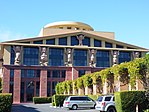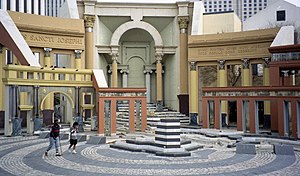From top, left to right: Vanna Venturi House (1964) by Robert Venturi; Team Disney building in Burbank, California (1990) by Michael Graves; Guild House (1963) in Philadelphia by Robert Venturi; 550 Madison Avenue (1984) by Philip Johnson and John Burgee; One PPG Place (1984) in Pittsburgh by Philip Johnson; Piazza d'Italia, New Orleans by Charles Moore (1978). | |
| Years active | Late 1950s–early-to-mid 2000s |
|---|---|
| Location | International |
| Influences | International style and modern |
| Postmodernism |
|---|
| Preceded by Modernism |
| Postmodernity |
| Fields |
| Reactions |
| Related |
Postmodern architecture is a style or movement which emerged in the 1960s as a reaction against the austerity, formality, and lack of variety of modern architecture, particularly in the international style advocated by Philip Johnson and Henry-Russell Hitchcock.[1] The movement was formally introduced by the architect and urban planner Denise Scott Brown and architectural theorist Robert Venturi in their 1972 book Learning from Las Vegas. The style flourished from the 1980s through the 1990s, particularly in the work of Scott Brown & Venturi, Philip Johnson, Charles Moore and Michael Graves. In the late 1990s, it divided into a multitude of new tendencies, including high-tech architecture, neo-futurism, new classical architecture, and deconstructivism.[2] However, some buildings built after this period are still considered postmodern.[3]
- ^ Encyclopedia Britannica on line, "Postmodernism", in "Western Architecture in the 20th century" (consulted September 19, 2024)
- ^ Hopkins 2014, p. 200.
- ^ Katherine McGrath (18 February 2020). "15 Playfully Bold Examples of Postmodern Architecture". Architectural Digest.





